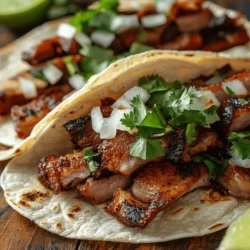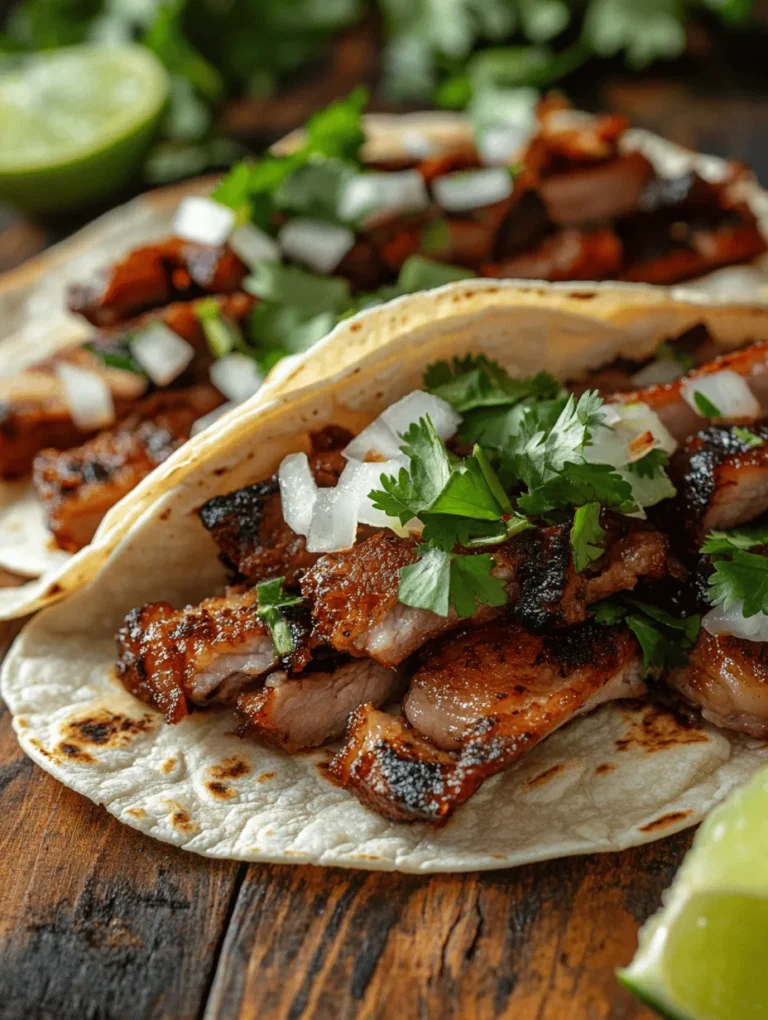Introduction to Traditional Mexican Cuisine
Mexican cuisine is a vibrant tapestry of flavors, colors, and textures that has captivated food lovers around the world. It is celebrated for its dynamic use of fresh ingredients, bold spices, and traditional cooking techniques that come together to create unforgettable dishes. Each recipe tells a story, reflecting the rich cultural heritage and culinary artistry that have been passed down through generations. In this article, we will explore five unique traditional Mexican recipes that you can easily recreate in your own kitchen. These dishes—Tacos al Pastor, Enchiladas Verdes, Chiles Rellenos, Pozole Rojo, and Flan Napolitano—are not just meals; they are gateways into the heart of Mexico.
Exploring Tacos al Pastor: A Flavorful Classic
Among the many iconic dishes that define Mexican street food culture, Tacos al Pastor stands out as a crowd favorite. This beloved dish has a fascinating backstory that reflects the blending of cultures. Its origins can be traced back to the early 20th century when Lebanese immigrants brought the concept of shawarma to Mexico. The local chefs adapted this technique, creating a unique dish that features marinated pork cooked on a vertical spit, similar to the traditional shawarma preparation. The result is a tantalizing blend of flavors that has become synonymous with Mexican culinary tradition.
Tacos al Pastor are characterized by their succulent, marinated pork, which is grilled to perfection and served in warm corn tortillas. The vibrant toppings and accompaniments enhance the flavors, making every bite an explosion of taste. Whether enjoyed as a quick street food snack or a full meal, Tacos al Pastor embodies the essence of Mexican cuisine—rich, bold, and utterly satisfying.
Ingredients and Preparation of Tacos al Pastor
To make authentic Tacos al Pastor at home, you’ll need a selection of fresh ingredients to capture the essence of this classic dish. Below is a detailed list of ingredients, along with step-by-step preparation instructions.
Ingredients
– For the Marinade:
– 2 pounds of pork shoulder, thinly sliced
– 4 dried guajillo chilies, seeds removed
– 2 dried ancho chilies, seeds removed
– 1/2 cup of pineapple juice
– 1/4 cup of white vinegar
– 4 cloves of garlic, minced
– 1 teaspoon of cumin
– 1 teaspoon of dried oregano
– 1 teaspoon of black pepper
– 1/2 teaspoon of salt
– 1/2 teaspoon of ground cloves
– 1/2 cup of chopped fresh pineapple (for grilling)
– For Serving:
– Corn tortillas
– Fresh cilantro, chopped
– White onion, finely diced
– Lime wedges
– Salsa (your choice of heat)
Step-by-Step Preparation Instructions
1. Prepare the Marinade:
– Begin by rehydrating the dried guajillo and ancho chilies. Place them in a bowl of hot water for about 15-20 minutes until softened. Drain and chop them into smaller pieces.
– In a blender, combine the softened chilies, pineapple juice, white vinegar, minced garlic, cumin, oregano, black pepper, salt, and ground cloves. Blend until you achieve a smooth paste.
2. Marinate the Pork:
– In a large mixing bowl, combine the sliced pork shoulder with the marinade. Make sure the pork is well coated. Cover the bowl with plastic wrap and refrigerate for at least 4 hours, preferably overnight. This marination period allows the flavors to penetrate the meat deeply, resulting in a more flavorful taco.
3. Prepare the Grill:
– Preheat your grill to medium-high heat. If using a stovetop, you can use a grill pan or cast-iron skillet to achieve similar results.
4. Grill the Pork:
– Once the grill is hot, remove the pork from the marinade, shaking off any excess. Grill the pork slices for about 4-5 minutes per side or until they are nicely charred and cooked through. During the last few minutes of grilling, add the chopped fresh pineapple to the grill to caramelize slightly. This will enhance the sweetness and provide a delightful contrast to the savory pork.
5. Slice and Serve:
– Once the pork is cooked, remove it from the grill and allow it to rest for a few minutes. Then, slice it into small, bite-sized pieces.
Importance of Marination and Grilling Techniques
The marination process is crucial for achieving the authentic flavor profile of Tacos al Pastor. The combination of spices and the acidity from the pineapple juice and vinegar helps tenderize the pork, making it juicy and flavorful. The grilling technique adds a smoky char that complements the marinade beautifully, enhancing the overall taste of the dish.
By following these detailed steps, you can create Tacos al Pastor that rival those found at your favorite taquería. The preparation is straightforward, making it an excellent option for both novice cooks and seasoned chefs alike.
Serving Suggestions and Accompaniments
To serve your Tacos al Pastor, warm up the corn tortillas on the grill or a hot skillet until they are pliable. Assemble the tacos by placing a generous portion of grilled pork in each tortilla. Top with fresh cilantro, diced onion, and a squeeze of lime juice for an extra zing.
For those who enjoy a bit of heat, consider adding your favorite salsa—whether it’s a tangy tomatillo salsa or a spicy red salsa, the choice is yours! Pair your tacos with traditional Mexican beverages, such as horchata or a refreshing agua fresca, to complete the experience.
Tacos al Pastor are not just a meal; they are a celebration of the flavors and traditions of Mexico. Each bite is a reminder of the country’s rich culinary heritage, inviting you to savor the taste of history and culture.
In the upcoming sections, we will continue to explore other traditional Mexican recipes, such as Enchiladas Verdes and Chiles Rellenos, each offering their unique flavors and stories. Stay tuned for more delicious recipes that will bring the spirit of Mexico to your dining table.
Step-by-Step Instructions for Roasting and Frying Chiles Rellenos
To create the perfect Chiles Rellenos, the process of roasting and frying is essential. Follow these simple steps to prepare your chiles for stuffing:
1. Roasting the Chiles:
– Preheat your oven to 425°F (220°C) or prepare an open flame on your stovetop (using a gas burner).
– Place the poblano chiles on a baking sheet or directly over the flame. Roast them until the skin is charred and blistered, turning occasionally to ensure even cooking.
– If using an oven, this will take about 20-25 minutes. If using a stovetop flame, it may take about 10-15 minutes, depending on the intensity of the flame.
– Once roasted, transfer the chiles to a bowl and cover with plastic wrap or a kitchen towel to steam. This will make peeling easier.
2. Peeling the Chiles:
– After about 10-15 minutes of steaming, remove the chiles. The skin should be soft and easy to peel away. Carefully peel off the charred skin, ensuring not to break the chiles.
– Make a small slit in each chile and gently remove the seeds and membranes. Be careful not to tear the flesh of the chiles.
3. Preparing the Batter:
– In a mixing bowl, beat 4 large eggs until frothy, adding a pinch of salt.
– Gradually fold in 1/2 cup of all-purpose flour, mixing until just combined. The batter should be thick but still pourable.
4. Frying the Chiles:
– Heat a deep skillet or frying pan over medium heat, and add enough vegetable oil to cover the bottom of the pan (about 1/2 inch deep).
– Once the oil is hot, dip each stuffed chile into the batter, allowing any excess to drip off before placing it in the hot oil.
– Fry the chiles for about 3-4 minutes on each side until they are golden brown and crispy. Remove them and place them on a plate lined with paper towels to absorb excess oil.
Tips for Achieving the Perfect Batter
– Egg Temperature: Using room temperature eggs can help achieve a fluffier batter. Allow your eggs to sit out for about 30 minutes before using them.
– Avoid Overmixing: When incorporating flour into the beaten eggs, mix just until combined. Overmixing can lead to a dense batter, while a light hand will create a fluffier texture.
– Oil Temperature: To check if your oil is hot enough, drop a small amount of batter into the oil; it should sizzle and rise to the surface. If it browns too quickly, the oil is too hot. If it sinks, the oil isn’t hot enough.
– Rest the Batter: Letting the batter sit for about 10 minutes before using can create a lighter texture.
Serving Ideas and Variations
Chiles Rellenos are fantastic on their own but can be enhanced further with sauces and variations.
Suggestions for Sauces to Pair with Chiles Rellenos
1. Tomato Sauce: A simple tomato sauce made with sautéed onions, garlic, and fresh tomatoes adds a tangy flavor that pairs beautifully with the richness of the cheese-stuffed chiles.
2. Green Sauce (Salsa Verde): A zesty green sauce made from tomatillos, cilantro, and jalapeños provides a fresh and spicy kick.
3. Mole Sauce: For a more decadent option, consider drizzling a rich mole sauce over your chiles. It adds depth and a complex flavor profile to the dish.
Exploration of Alternative Stuffing Ingredients
While traditional Chiles Rellenos are often stuffed with cheese, you can get creative with the filling:
– Meat: Ground beef or shredded chicken mixed with spices can create a hearty filling.
– Vegetarian Options: Consider using a mix of sautéed mushrooms, zucchini, or spinach for a delightful vegetarian option.
– Seafood: For a unique twist, try mixing crab or shrimp with a rich cream cheese filling.
Pozole Rojo: A Hearty Hominy Stew
Pozole Rojo is a traditional Mexican stew that is both hearty and nourishing. Made with tender pork and hominy, this dish is often enjoyed during celebrations and family gatherings.
Ingredients and Preparation of Pozole Rojo
Ingredients:
– 2 pounds of pork shoulder, cut into chunks
– 1 onion, chopped
– 6 cloves of garlic, minced
– 2 dried ancho chiles
– 2 dried guajillo chiles
– 1 can (15 oz) of hominy, drained and rinsed
– 8 cups of chicken broth
– 1 tablespoon of oregano
– Salt and pepper to taste
– Optional garnishes: chopped radishes, shredded cabbage, lime wedges, and avocado
Preparation Steps:
1. Soak the Chiles: In a bowl, soak the dried ancho and guajillo chiles in hot water for about 30 minutes until softened. Once softened, remove the stems and seeds.
2. Prepare the Chile Sauce: Blend the soaked chiles with 1 cup of chicken broth until smooth. Set aside.
3. Cook the Pork: In a large pot, add the pork, chopped onion, garlic, and remaining chicken broth. Bring to a boil, then reduce heat and simmer for about 1.5 to 2 hours, or until the pork is tender.
4. Add the Chile Sauce: After the pork is tender, stir in the blended chile sauce and hominy. Simmer for an additional 30 minutes to allow the flavors to meld.
5. Season: Add oregano, salt, and pepper to taste.
Importance of Simmering for Flavor Development
Simmering the stew allows the flavors to develop and deepen. The longer the pork cooks, the more tender it becomes, and the spices and chiles infuse their flavors into the broth. Aim for a rich, flavorful broth that complements the hearty hominy.
Toppings and Cultural Significance
Traditional Toppings
To serve Pozole Rojo, consider offering a variety of toppings for guests to customize their bowls:
– Radishes: Sliced radishes add a crunchy texture and a peppery bite.
– Cabbage: Shredded cabbage brings freshness and a nice crunch.
– Lime: Squeezing fresh lime juice over the dish brightens the flavors.
– Avocado: Creamy avocado slices enhance the richness of the stew.
Discussion of Pozole in Mexican Culture and Celebrations
Pozole is more than just a dish; it holds cultural significance in Mexican traditions. Often served during holidays like Mexican Independence Day and Christmas, it is a dish that brings families together. Each region of Mexico has its own variations of pozole, often made with different meats or spices, reflecting the diversity of the culture.
Flan Napolitano: A Sweet End to the Meal
To round off this culinary journey, Flan Napolitano provides a sweet and creamy dessert that is a favorite across Mexico. This classic treat features rich flavors of caramel and vanilla.
Ingredients and Preparation of Flan Napolitano
Ingredients:
– 1 cup of sugar (for caramel)
– 1 can (14 oz) of sweetened condensed milk
– 1 can (12 oz) of evaporated milk
– 4 large eggs
– 1 tablespoon of vanilla extract
Preparation Steps:
1. Make the Caramel: In a saucepan, heat the sugar over medium heat until it melts and turns golden brown. Quickly pour the caramel into a round flan mold, tilting to coat the bottom evenly.
2. Blend the Flan Mixture: In a blender, combine the sweetened condensed milk, evaporated milk, eggs, and vanilla extract. Blend until smooth.
3. Pour into Mold: Carefully pour the mixture over the set caramel in the mold.
4. Baking in a Water Bath: Place the flan mold in a larger baking dish and fill the dish with hot water halfway up the sides of the flan mold. Bake at 350°F (175°C) for about 50-60 minutes, or until the flan is set.
5. Cool and Unmold: Allow the flan to cool completely before inverting it onto a serving plate. The caramel will flow over the top as a sauce.
Explanation of the Water Bath Baking Technique
Baking the flan in a water bath (bain-marie) helps regulate the cooking temperature, ensuring even cooking and preventing the flan from cracking. This technique is essential for achieving that smooth, creamy texture that flan is known for.
Presentation and Serving Suggestions
For an elegant presentation of Flan Napolitano:
– Garnish: Add a dollop of whipped cream and a sprinkle of cinnamon on top for added flair.
– Plate: Serve on a decorative plate with a slice of flan drizzled with caramel sauce.
– Accompaniment: A side of fresh berries can add color and a refreshing contrast to the rich flavors of the flan.
Flan Napolitano is widely enjoyed during celebrations such as birthdays, holidays, and family gatherings, making it a versatile dessert choice that resonates with many.
Conclusion: Celebrating the Richness of Mexican Cuisine
The five traditional Mexican recipes highlighted in this article not only offer a delicious way to experience the flavors of Mexico but also celebrate the culture and history behind each dish. From the savory Tacos al Pastor to the sweet Flan Napolitano, these recipes invite you to explore and appreciate the diverse culinary heritage of Mexico. Whether you are cooking for family, friends, or a special occasion, these dishes are sure to bring joy and satisfaction to your table. Enjoy the process of cooking and the delightful tastes that come from these beloved recipes, as they represent the heart and soul of Mexican gastronomy.



